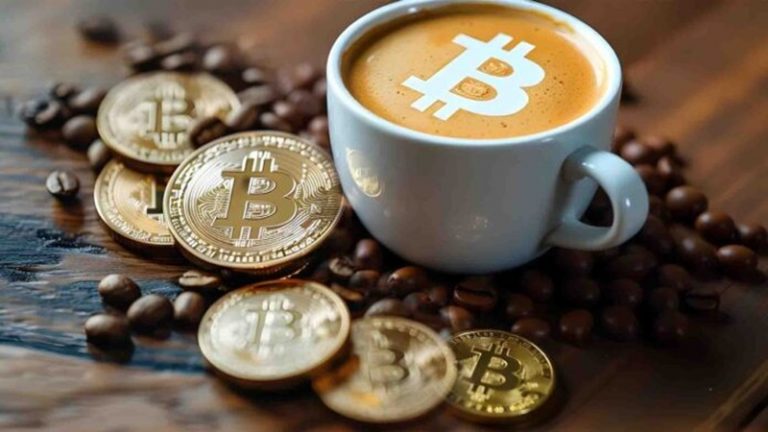
Vanadi Coffee SA, a Spanish coffee chain, has proposed a plan to invest approximately $1.1 billion (€1 billion) in Bitcoin, aiming to pivot from a traditional coffee business to a “Bitcoin-first” company. This strategy, led by Chairman Salvador Martí, is inspired by MicroStrategy’s approach to accumulating Bitcoin as a treasury reserve asset. The proposal, which involves raising funds through stock issuance and convertible financing, is set to be reviewed by the board on June 29, 2025.
Vanadi’s move comes amid financial struggles, with the company reporting a $3.7 million net loss in 2024, exceeding its annual revenue of $2.28 million, and a 91% drop in its stock price (VANA) since its July 2023 IPO. Martí already tested the strategy by purchasing 5 BTC for $527,110, which briefly boosted the stock price by 22% before it fell back to €0.28 ($0.32) as Bitcoin’s price dropped from $111,000 to $105,000. This volatility highlights the risks of tying the company’s financial health to Bitcoin’s price fluctuations.
While some see this as a bold move to capitalize on Bitcoin’s potential as a hedge against inflation and attract tech-savvy investors, critics like Jacob King of WhaleWire argue it’s a publicity stunt, noting Vanadi’s small scale (six locations) and limited online presence. The plan’s success hinges on shareholder approval and Bitcoin’s market performance, with analysts projecting potential BTC price targets of $114,000–$120,000 if bullish trends continue. However, the European regulatory environment and Bitcoin’s volatility pose significant risks.
Register for Tekedia Mini-MBA edition 19 (Feb 9 – May 2, 2026): big discounts for early bird.
Tekedia AI in Business Masterclass opens registrations.
Join Tekedia Capital Syndicate and co-invest in great global startups.
Register for Tekedia AI Lab: From Technical Design to Deployment (next edition begins Jan 24 2026).
Vanadi Coffee’s audacious plan to invest $1.1 billion in Bitcoin signals a radical shift in its business model, with far-reaching implications for the company, its stakeholders, and the broader mmarket. Bitcoin’s price volatility (e.g., recent drop from $111,000 to $105,000) could destabilize Vanadi’s financial position, especially given its 2024 net loss of $3.7 million against $2.28 million in revenue. A significant Bitcoin price crash could exacerbate losses.
The initial 22% stock price surge after purchasing 5 BTC shows market sensitivity to Bitcoin moves, but the subsequent drop to €0.28 reflects skepticism and volatility risks. A $1.1 billion bet could amplify these swings. Raising €1 billion through stock issuance and convertible financing may dilute existing shareholders’ equity and strain liquidity, especially for a company with only six locations and limited operational scale.
By emulating MicroStrategy, Vanadi aims to reposition itself as a crypto-focused entity, potentially attracting a new investor base (crypto enthusiasts, hedge funds). This could diversify its revenue streams beyond coffee sales. The move could enhance Vanadi’s brand among tech-savvy consumers but risks alienating traditional customers and investors wary of crypto’s speculative nature. European regulators, particularly in Spain, may impose stricter oversight due to Bitcoin’s association with financial instability and money laundering concerns, potentially complicating Vanadi’s operations.
A $1.1 billion Bitcoin purchase could drive short-term price increases, especially if executed during a bullish market (analysts project BTC at $114,000–$120,000). However, Vanadi’s small scale limits its influence compared to larger players like MicroStrategy. Success could inspire other small- to mid-sized firms to adopt Bitcoin as a treasury asset, accelerating corporate crypto adoption. Failure, however, could deter similar moves and reinforce skepticism.
Approval on June 29, 2025, will depend on shareholder confidence in Bitcoin’s long-term value versus Vanadi’s operational struggles. Dilution from stock issuance could spark dissent. A shift to a Bitcoin-first model may require operational changes, potentially affecting jobs or customer experience if resources are diverted from core coffee operations. Vanadi’s plan has sparked a polarized debate, reflecting broader tensions around corporate Bitcoin adoption:
Bitcoin maximalists and investors like those on X (e.g., posts citing MicroStrategy’s success) view this as a visionary move to hedge against inflation and fiat devaluation. They argue Bitcoin’s potential upside (e.g., projected $120,000 price) could transform Vanadi’s financial outlook. The strategy could attract younger, crypto-friendly investors, boosting Vanadi’s market relevance despite its small size.
Supporters believe Bitcoin’s integration could modernize Vanadi’s brand, making it a pioneer in blending traditional business with crypto innovation. Analysts like Jacob King (WhaleWire) call it a “publicity stunt,” arguing Vanadi’s $2.28 million revenue and six locations lack the scale for a $1.1 billion crypto bet. Critics highlight the risk of insolvency if Bitcoin crashes. Shareholders wary of crypto’s volatility and Vanadi’s 91% stock price drop since its 2023 IPO may see this as a desperate gamble rather than a strategic pivot.
Critics note Europe’s cautious stance on crypto, with potential for regulatory pushback or penalties that could hinder Vanadi’s plan. The divide reflects differing views on Bitcoin’s role in corporate finance—innovative asset versus speculative gamble. Vanadi’s success will depend on. Executing purchases during a Bitcoin bull run could validate supporters, while a bear market could embolden critics. Clear communication about risk management (e.g., hedging strategies) could ease shareholder concerns.
Maintaining coffee operations while integrating Bitcoin will be crucial to avoid alienating customers and employees. Ultimately, Vanadi’s move is a high-stakes experiment that could either redefine its future or underscore the risks of tying a small business to a volatile asset. The June 29, 2025, board decision will be pivotal in determining which side of the divide prevails.



